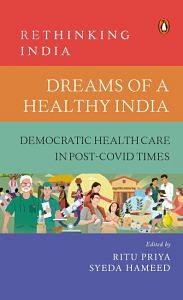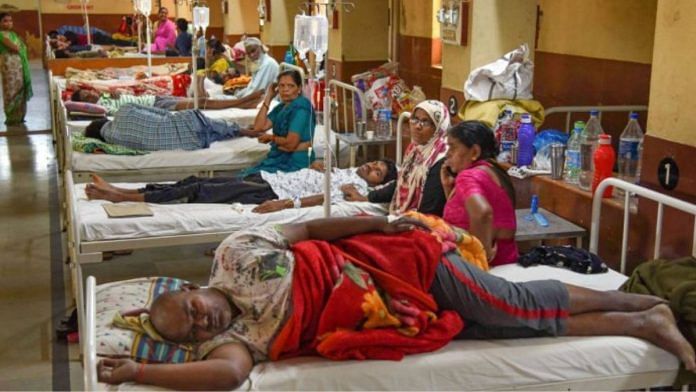With a policy steadfastness, the new Chhattisgarh is now a model of evolving health systems. The government initiatives are exemplary efforts to enhance the health-care ecosystem into a robust one. Policies designed around community-centricmechanisms and grievance redressal have brought a swift change in the health narrative of the state. The decision of the government to make treatment methods more inclusive also shows its enthusiasm towards its culturally rich history and traditions.
Swimming Against the Tide: Focus on Public System Strengthening Instead of a Private Sector-Led Insurance Model
Chhattisgarh, like the rest of the country, has a mixed healthcare system with public and private providers. The first set of improvements was directed at community-level government services in the coverage of child immunization and antenatal care, with a somewhat longer effort to achieve desired improvements in disease-control. The most difficult area to improve in Chhattisgarh, however, was the availability and quality of institutional care. The state inherited poor infrastructure and a very poor availability of doctors, nurses and other medical human resources.
Chhattisgarh initially experimented with developing its hospital services through an insurance model. It was a leading implementer of the Rashtriya Swasthya Bima Yojana (RSBY) or the National Health Insurance Scheme for below-poverty-line (BPL) families from 2008 onwards. It added its own insurance schemes to increase coverage of insurance to around 80 per cent of the population. The vertical cover was increased manifold in 2018 when the state adopted the new national scheme of PMJAY. The Pradhan Mantri Jan Arogya Yojana (PMJAY) under the Ayushman Bharat scheme, the upscaled version of the hitherto implemented health insurance programme called Rashtriya Swasthya Bima Yojana (RSBY), is a health insurance scheme where the Central government pays a premium to the insurance company, which guarantees health care only for certain illnesses for those who are admitted to empanelled hospitals for selected people judged to be poor by the SECC survey of 2011, and up to an amount of Rs 5,00,000 per family. To be noted is that the premium given by the Central government covers only up to Rs 50,000 per family and any additional expenses is paid by the state government via a trust model (for the state of Chhattisgarh).
However, various studies showed that the coverage provided though such schemes had several important gaps. The schemes tried to improve access to health care by empanelling private hospitals. However, most of the private sector was concentrated in a few urban areas. The neediest populations lived in rural areas, including the tribal belts, where the availability of services did not increase despite people getting enrolled under insurance programmes. PMJAY does not look after those illnesses that require outpatient care and does not look at preventive or promotive health care. Primary and secondary care account for 70 per cent of all healthcare interventions.
Further, the out-of-pocket expenditure for those able to utilize the insurance schemes did not come down. Private hospitals continued to charge extra from majority of patients and it was difficult to regulate and control such practices. Patients going in for simple illnesses ended up being subjected to unnecessary procedures by private hospitals, highlighted by instances such as where patients had their uteruses removed without due medical process. There was a mushrooming of private facilities, and insurance schemes helped the migration of financial and human resources from the public to private sector. Private health-care practitioners provide a narrow and selective range of services and cater to the needs of the richer population to gain profits.
The idea that it might be more desirable to invest in and strengthen the government sector was akin to swimming against the tide because of the wider belief of policymakers that people preferred private services to public health care, which was perceived as non-responsive and of poor quality. Further, the predominant perception was that the private sector provided close to 80 per cent of the medical care in India and, therefore, any approach without aid from this sector or which did not rely on it was bound to fail. Chhattisgarh, however, took the bold decision to build its public sector both for primary and ambulatory care as well as for inpatient hospital care.
Prior to 2019, the Hybrid Health Financing Model was adopted by the Ayushman Bharat Scheme, where a private insurance company was tendered. The Ayushman Bharat Scheme would provide a maximum sum of Rs 1102 per family, which was shared between the Centre and state in the ratio of 60:40. When a tender was done for an insurance company to provide a health coverage using this money, the lowest bidder bid Rs 1100 per family and provided for only Rs 50,000 coverage (sum insured) for the family. Thus, if the family incurred a health claim of, say, Rs 1,00,000, the amount provided by Ayushman Bharat would cover only Rs 50,000 and the state government would have to pay the additional Rs 50,000 from its treasury. This was settled internally by the State Nodal Agency. Thus, the claim that Ayushman Bharat provided for a coverage of Rs 5 lakh per family is not completely accurate.
Even this allocation was available for only 63 per cent (42 lakh) families as per the SECC database. The remaining families (excluding the families of government servants who accounted for around 6 per cent) were provided a coverage of Rs 50,000 only under the Mukhyamantri Swasthya Bima Yojana (MSBY).
In 2019, it was then decided by the Chhattisgarh government to merge all existing Health Coverage Schemes (AB, MVSSY, Sanjeevni, Bal Shravan Yojna, Bal Hriday Yojna, Chirayu, etc.) into the Ayushman Bharat-Dr. Khubchand Baghel Swasth Sahayata Yojna, which would provide a coverage of Rs 5 lakh for all families with Antyodaya Ration Cards (90 per cent of families in Chhattisgarh) and the remaining families (excluding the families of government servants) would be provided a coverage of Rs 50,000 only. Apart from this, under the Mukhyamantri Vishesh Swasth Sahayata Yojna, a support of up to Rs 20 lakh was to be provided for fourteen rare conditions for all families of Chhattisgarh (families above the poverty line would need the approval of the chief minister).
It was also decided to shift from the Hybrid Health Financing Model, which had a very high administrative expense (15 per cent), to the Trust Health Financing Model. Under the Trust Model, it was decided to use the services of two Third Party Administrators. One TPA would be responsible for claim processing and the second TPA would audit the claims processed by the first TPA. By deviating from the national model, the state is thus saving large sums in premiums by directly handling the insurance operations rather than through a private company.
The Trust Model has shifted the emphasis from empanelling the private sector to a more judicious mix of public and private providers, building on the strengths of each. The funding imbalance between private and public sector has been corrected to an extent, from only 15 per cent of the claim amount going to the public sector till 2018, to around 45 per cent of the claim amount going to it in 2021. With a clear goal of strengthening the public system, incentives for HR in public hospitals have been enhanced.
 This excerpt from Dreams of a Healthy India: Democratic Healthcare in Post-Covid Times, the ninth volume in the Rethinking India series, edited by Ritu Priya and Syeda Hameed, has been published with permission from Penguin India.
This excerpt from Dreams of a Healthy India: Democratic Healthcare in Post-Covid Times, the ninth volume in the Rethinking India series, edited by Ritu Priya and Syeda Hameed, has been published with permission from Penguin India.



